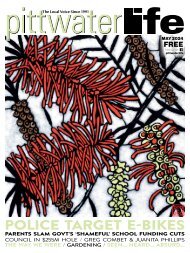Pittwater Life January 2024 Issue
LOCAL GUIDE: 193 THINGS TO DO 1991‘DEVELOPMENT ONSLAUGHT’ FEARS / BEACHES ACHIEVERS HOLIDAY CROSSWORD + PUZZLES / BARRENJOEY BOATSHED THE WAY WE WERE / HOT PROPERTY / SEEN... HEARD... ABSURD...
LOCAL GUIDE: 193 THINGS TO DO
1991‘DEVELOPMENT ONSLAUGHT’ FEARS / BEACHES ACHIEVERS
HOLIDAY CROSSWORD + PUZZLES / BARRENJOEY BOATSHED
THE WAY WE WERE / HOT PROPERTY / SEEN... HEARD... ABSURD...
Create successful ePaper yourself
Turn your PDF publications into a flip-book with our unique Google optimized e-Paper software.
Garden <strong>Life</strong><br />
with Gabrielle Bryant<br />
Garden <strong>Life</strong><br />
Alcantareas add drama and<br />
colour to landscape design<br />
Bromeliads are easy to grow. In recent<br />
years they have become more and<br />
more popular as landscaping plants,<br />
where low maintenance is required. They<br />
multiply quickly, needing very little water<br />
and thriving in full sun or semi-shade.<br />
Exotic colours of red, purple, variegated<br />
green and white or soft grey bromeliads<br />
will fill the gaps in tropical gardens<br />
amongst gingers, cordylines, palms and<br />
crotons.<br />
The family is vast and very adaptable.<br />
Bromeliads are epiphytic plants that grow<br />
naturally on logs, posts or dead tree<br />
stumps. They will not harm their host<br />
plant; they only use it for support. Instead<br />
of growing them in<br />
pots try strapping them<br />
to a log and making a<br />
bromeliad tree.<br />
The smallest are the<br />
tiny air plants, tillandsias,<br />
that will even grow<br />
attached to magnets on<br />
the fridge. The brightflowering<br />
vriesias, often<br />
grown as indoor plants,<br />
send up tall flower<br />
spikes of yellow, scarlet,<br />
or brilliant orange. The<br />
medium-sized, deep<br />
purple, red or speckled<br />
guzmanias, the striped<br />
cryptanthus (with their<br />
crinkled leaves known<br />
as Earth Stars), the pale<br />
grey billbergias with their<br />
pendulous pink spray of<br />
flowers, the grey-striped<br />
aechmea that produces<br />
a huge pink and violet<br />
flower and even the<br />
pineapple(!) all belong to the family.<br />
Last, but not least, is the giant alcantarea<br />
imperialis rubra.<br />
Alcantareas have become the favourite<br />
of the landscaper brigade. These huge<br />
spectacular bromeliads grow in rosette<br />
form to a width and height of 1.5m. The<br />
more sun they get, the richer the colour. If<br />
grown in the shade they will become dark<br />
green with reddish tips. They add drama to<br />
any landscape design, either as a feature<br />
plant or grown as a centrepiece in pots.<br />
They can take any length of time to<br />
flower, from 8-15 years. The tall spikes of<br />
flower are produced from the centre. White,<br />
scented flowers appear from the red bracts<br />
that grow along the 3m<br />
stems (pictured). They<br />
can be seen flowering<br />
now across the peninsula.<br />
These huge flowers look<br />
like Christmas decorated<br />
trees.<br />
As with all bromeliads,<br />
once they have flowered,<br />
they will begin to die<br />
back, and new pups will<br />
appear at the base of the<br />
plant. Separate the pups<br />
from the mother plant<br />
and grow them on as the<br />
next generation.<br />
To grow bromeliads<br />
in pots, use orchid mix –<br />
not potting mix – as they<br />
need excellent drainage<br />
to prevent the roots from<br />
root rot. Outdoors they<br />
can rely on rainwater<br />
and will only need to<br />
be watered after long<br />
periods of drought.<br />
Pink freckles<br />
a shooting star<br />
It can be hard to find a plant that will<br />
flower in full shade, and also grow with<br />
some dappled sunlight.<br />
Tricyrtis Shooting Stars Pink Freckles<br />
(above) will light up the dark areas of the<br />
garden with orchid-like pale mauve or<br />
pink flowers that are speckled with violet<br />
spots in late summer and autumn. For<br />
added colour, mix the pink freckles with<br />
blue and mauve varieties.<br />
I am not sure why these showy<br />
herbaceous plants have been given the<br />
name of ‘Toad Lilies’. They look delicate<br />
but are hardy and easy to grow. With<br />
rhizomes underground that slowly creep<br />
along, they will soon develop into a<br />
dense patch of shiny green foliage.<br />
Left alone the toad lily will naturalise<br />
but never become invasive. Cut back the<br />
leaves and old flowers in early winter<br />
and new growth will appear in spring.<br />
70 JANUARY <strong>2024</strong><br />
The Local Voice Since 1991
















